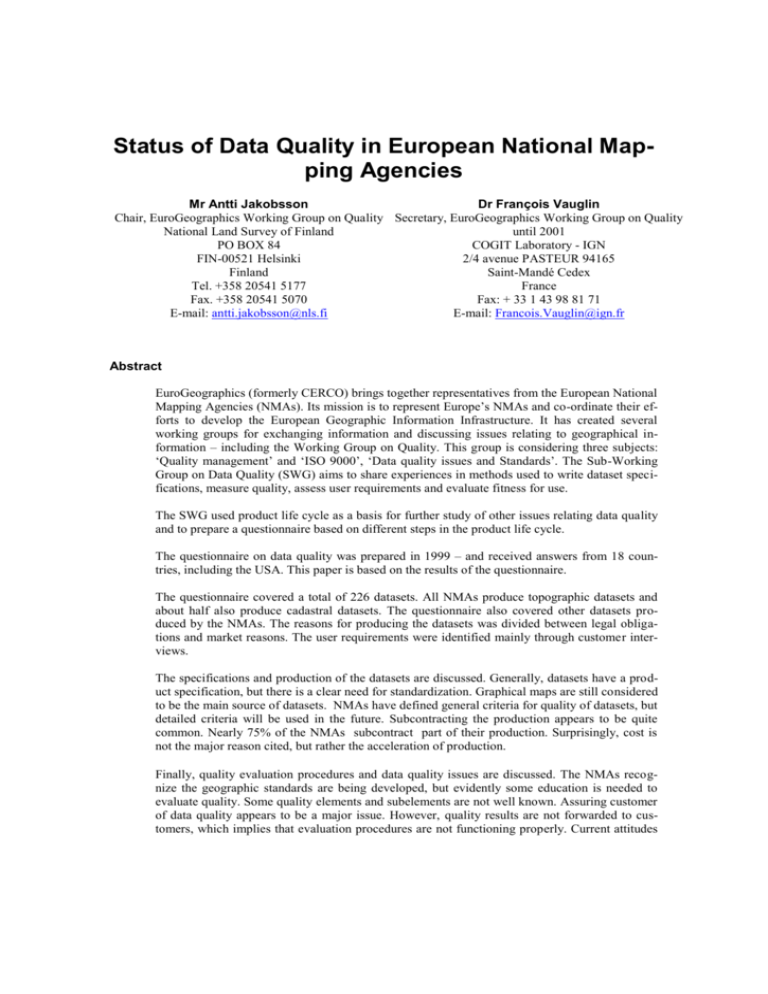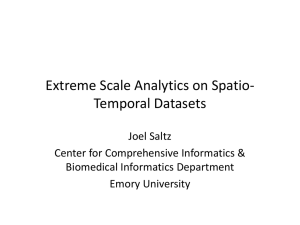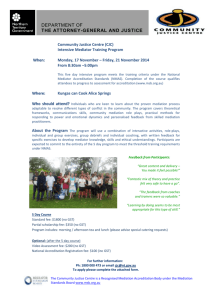The status of data quality in the European national mapping agencies
advertisement

Status of Data Quality in European National Mapping Agencies Mr Antti Jakobsson Dr François Vauglin Chair, EuroGeographics Working Group on Quality Secretary, EuroGeographics Working Group on Quality National Land Survey of Finland until 2001 PO BOX 84 COGIT Laboratory - IGN FIN-00521 Helsinki 2/4 avenue PASTEUR 94165 Finland Saint-Mandé Cedex Tel. +358 20541 5177 France Fax. +358 20541 5070 Fax: + 33 1 43 98 81 71 E-mail: antti.jakobsson@nls.fi E-mail: Francois.Vauglin@ign.fr Abstract EuroGeographics (formerly CERCO) brings together representatives from the European National Mapping Agencies (NMAs). Its mission is to represent Europe’s NMAs and co-ordinate their efforts to develop the European Geographic Information Infrastructure. It has created several working groups for exchanging information and discussing issues relating to geographical information – including the Working Group on Quality. This group is considering three subjects: ‘Quality management’ and ‘ISO 9000’, ‘Data quality issues and Standards’. The Sub-Working Group on Data Quality (SWG) aims to share experiences in methods used to write dataset specifications, measure quality, assess user requirements and evaluate fitness for use. The SWG used product life cycle as a basis for further study of other issues relating data quality and to prepare a questionnaire based on different steps in the product life cycle. The questionnaire on data quality was prepared in 1999 – and received answers from 18 countries, including the USA. This paper is based on the results of the questionnaire. The questionnaire covered a total of 226 datasets. All NMAs produce topographic datasets and about half also produce cadastral datasets. The questionnaire also covered other datasets produced by the NMAs. The reasons for producing the datasets was divided between legal obligations and market reasons. The user requirements were identified mainly through customer interviews. The specifications and production of the datasets are discussed. Generally, datasets have a product specification, but there is a clear need for standardization. Graphical maps are still considered to be the main source of datasets. NMAs have defined general criteria for quality of datasets, but detailed criteria will be used in the future. Subcontracting the production appears to be quite common. Nearly 75% of the NMAs subcontract part of their production. Surprisingly, cost is not the major reason cited, but rather the acceleration of production. Finally, quality evaluation procedures and data quality issues are discussed. The NMAs recognize the geographic standards are being developed, but evidently some education is needed to evaluate quality. Some quality elements and subelements are not well known. Assuring customer of data quality appears to be a major issue. However, quality results are not forwarded to customers, which implies that evaluation procedures are not functioning properly. Current attitudes on quality and the need for proper quality specification indicate the possibility that remaining issues will be solved in the future. 1. Introduction to EuroGeographics and the Working Group on Quality EuroGeographics (formerly CERCO, the Comite Europeen de Responsibles da la Cartographie Officielle) brings together representatives from the European National Mapping Agencies (NMAs). Its mission is to represent Europe’s NMAs and co-ordinate their efforts to develop the European Geographic Information Infrastructure. Currently, it has members from 37 nations. EuroGeographics has two products: the Geographical Data Description Directory (GDDD) – a metadata service available on the Internet (www.eurogeographics.org), and a dataset of administrative areas of Europe (SABE, the Seamless Administrative Boundaries of Europe) It also has a number of on-going projects covering global and pan-European initiatives as EuroGlobalMap (1:1 million) and EuroRegionalMap (1:250,000). It has created several working groups for exchanging information and discussing issues relating to geographical information. One of these, the Working Group on Quality, was created in September 1997 and is working on three main subjects: ‘Quality management and ISO 9000’, ‘Data quality issues’ and ‘Standards’. The mission of the Sub-Working Group on Data Quality (SWG) is to share experiences in methods used to write dataset specifications, measure quality, assess user requirements and evaluate fitness for use. The Working Group has created a network of experts dealing with quality management and data quality among member organizations. It has produced two guidebooks: Good Reasons for Implementing a Quality Management System and a Handbook for Implementing a Quality Management System. This paper focuses on the report covering the questionnaire on data quality made to the member organizations in 1999. 2. Introduction to the data quality questionnaire The SWG organized a workshop in Paris in 1998. As a result of this, the SWG used product life cycle as a basis for further study of different issues regarding data quality. The approach was presented by Dassonville, Vauglin, Jakobsson and Luzet (1999). After comparison of the NMAs’ production organizations, 5 major steps were identified: 1. 2. 3. 4. 5. To identify user requirements To specify products meeting the requirements of step 1 To produce data meeting the specifications of step 2 To check what has been correctly produced in step 3 To deliver data checked in step 4 to users and to prepare for testing if requirements were correctly identified in step 1. The objectives of the questionnaire were: To determine the major data quality issues for NMAs To share information on data quality procedures used at the NMAs in a product’s life cycle To arrange seminars on data quality that would focus on issues in which the NMAs need more information. The questionnaire was posted to the NMAs by mid-July 1999, and answers were requested by September 1999. The first draft report was presented at the Working Group meeting in Ankara in November 1999. The final result was presented in connection with the Working Group seminar in Stockholm 2000. 3. Material and methods The questionnaire was posted to the NMAs in Europe; there were 21 answers received from 18 countries. Of the answers, 20 were from Europe and one was received from the USA. The NMAs were: Bundesamt für Kartographie und Geodäsie (BKG), Germany Czech Office for Surveying, Mapping and Cadastre (CUZK), Czech Republic Estonian National Land Board, Estonia Federal Directorate of Cadastral Survey, Switzerland Federal Office of Metrology and Surveying (BEV), Austria Federal Office of Topography (BLT), Switzerland Ministry of National Defence, General Command of Mapping (GCM), Turkey Geodesy, Cartography and Cadastre Authority of the Slovak Republic, (ÚGKK) Institut Cartogràfic de Catalunya, Spain Institut Géographique National (IGN-F), France Institute of Aerial Geodesy, Lithuania Institute of Geodesy, Cartography and Remote Sensing (FÖMI), Hungary Instituto Geográfico Nacional (IGN) España, Spain Kort & Matrikelstyrelsen (KMS), Denmark National Land Survey of Finland (MML) National Land Survey of Sweden (Lantmäteriet) Ordnance Survey (OS), Great Britain Portuguese Institute for Cartography and Cadastre (IPCC), Portugal Surveying and Mapping Authority of the Republic of Slovenia (GURS) Topografische Dienst Nederland (TDN), The Netherlands United States Department of Commerce, Bureau of the Census, USA 4. Results Here we present shortly the main results; a full analysis can be found in the report, which will be made public later this year on the EuroGeographics website. 4.1 Datasets and user requirements All of the NMAs produce topographic datasets and about half also produce cadastral datasets. Other datasets produced include geodetic datasets, address files, land-use data and geologic data. In all, the NMAs identified a total of 226 different datasets produced. The reasons for producing the datasets could be divided into legal obligations and market reasons. User requirements were identified mainly through customer interviews. 4.2 Dataset specifications and production Most datasets have a product specification. Product specifications are based on a methodology developed in-house. Currently, there is no international standard on how to create specifications. Some datasets are based on international product specifications such as the Corine, the Digest etc. Product specifications may include: •Data dictionaries •Content specifications •Data Capture specifications •Technical specifications •User guides. The reference set used as a comparison for the dataset when checking data quality, can be the real world or other datasets, graphical maps or other sources. Graphical maps and the real world are used as references. Sometimes both the real world and other sources are used as a reference; e.g. a graphical map can be used in the data compilation process and then the final product is checked in the field. If a graphical map is the only source used in quality evaluation, it can mean that the currency of the dataset cannot be evaluated. In the future, when datasets are updated the real world should be used as a reference. 15 NMAs (72%) are currently subcontracting some parts of their production. Some NMAs, 3(14%), subcontract only very minor parts, while 3 NMAs do not subcontract at all. Aerial photography (57%) and data compilation (48%) are the most subcontracted processes in the production of base topographic datasets, others include quality evaluation etc. Quality evaluation is typically subcontracted in about 5-10% of dataset types. The entire production is subcontracted most in cadastral (19%) and base topographic data (14%), and least in derived topographic (5%) and imagery (5%) datasets. The reasons for subcontracting include: Production acceleration (57%) Lack of resources (52%) Political decision (43%) and Cost benefit (19%). The requirements given to subcontractors include: technical specifications, legal contracts and qualification of the subcontractor. Aerial photography and data compilation are most likely subcontracted. Topographic base datasets are subcontracted more than the others. 4.3 Quality elements We used the quality elements or parameters as defined in the European Prestandard (ENV 12656) and in the ISO 19113 Draft International Standard. The question was: Which quantitative quality elements and parameters (according to CEN/TC 287 and ISO TC 211 definitions) do you use? / Give also the quality measure that you use. Table 1 presents the results. Table 1. Use of quality elements Quality element Nonquantitative quality elements Purpose Usage Lineage % of NMAs using 57 48 71 Quality element Source Process step Producer organization Date of production User-defined % of NMAs using 81 48 62 57 5 User-defined Quantitative quality elements 5 Completeness Omission Commission User-defined 52 43 38 5 Logical consistency 52 43 5 Absolute accuracy Relative accuracy Relative horizontal Relative vertical Adjacent entities Gridded data positional accuracy Accuracy of geographic identifiers User-defined 67 29 43 33 24 19 24 5 Positional accuracy 62 Topological consistency, Format consistency Domain, Geometric, Semantic consistency User-defined 62 Temporal accuracy Last update Temporal validity, Temporal consistency Time measurement, Rate of change Temporal lapse 38 52 19 14 10 Thematic accuracy Quantitative attribute, Qualitative attribute, Classification correctness Accuracy of spelling Agreement for an attribute Likely misclassification, Consistency of abbreviations 43 38 29 24 19 In essence, the terminology used appears to be unclear to the NMAs. Some subelements are used more than the element itself, and some others are not standardized in the ISO 19113. The use of very common quality elements appeared to be quite low, e.g. positional accuracy is used only 62% of the time. 4.4 Quality evaluation The question was: Which quality elements and parameters do you test and what types of methods do you use to evaluate quality? The NMAs responded that positional accuracy is evaluated in 71%, completeness in 63% and thematic accuracy in 46% of the dataset types produced. Temporal accuracy and aggregate results are not commonly evaluated. Sampling methods are not based on the use of standards: 67% of the NMAs use no standards while only 19% do. The questionnaire listed 2 standards (ISO 2859 and ISO 3951) that could be used. ISO 2859 is used by 1 NMA and 2 use their own standard; 1 used a standard, but did not specify which one. The different sampling methods that are used include: Simple random sampling 36% Stratified sampling 45% Multistage sampling 9% and Other 1% Aggregation is not used. Only 1 NMA stated the usage of aggregation for themselves and for their customers. Quality criteria, including target value(s) for quality, are used in 58% of the dataset types. Cadastral and imagery datasets use commonly defined quality criteria. 4.5 Data delivery 71% of NMAs offer no warranty for quality. Only 29% of NMAs offer warranties covering aspects such as technical correctness, legal responsibility and correctness of delivery. 59% of the datasets are delivered without quality results; imagery datasets more often include quality results (56%). 60% of users require quality results for some datasets. 80% or more users of cadastral datasets need quality results while 50% of users of derived topographic datasets need quality results. 4.6 Opinions In the questionnaire some statements were given to determine the general opinions regarding quality in NMAs. International Cartographic Association (ICA) used the same statements earlier (Östman 1997). There is very strong consensus that NMAs have recognized the need for proper data quality specification (mean 4,1) and for educational material concerning data quality specifications and assurance routines (mean 4,2). The average for the following statements was about 3. Figure 1 depicts the results. 1. Strongly disagree 2 3. Partly true Our current quality assurance routines are sufficient for a proper specification of data quality and assurance routines There is a great need for educational material concerning the specifications of data quality and assurance routines The requirements of our clients have a large impact on the design of our quality assurance routines The current quality specification of the datasets fulfils the needs of our clients Our current clients always require a data quality specification My organisation has recognised the needs of a proper data quality specification Figure 1. Opinions regarding quality 4. 5. Strongly agree 5. Discussion In December 1996 the ICA and its Commission on Spatial Data Quality posted a worldwide questionnaire to producers of spatial data. The questionnaire went to 288 NMAs, and a total of 56 responded, most from Europe (59%). Table 2 gives a short summary of the results (Östman, 1997). Table 2. Results of the ICA questionnaire: percentage of answers indicating subjective evaluation or no evaluation as a quality assurance routine (Östman, 1997) Quality parameters Positional accuracy Thematic accuracy Temporal accuracy Completeness Logical consistency Percentage 43% 48% 68% 56% 32% When we compare these results to our results regarding quality evaluation answers, it appears that positional accuracy, and completeness are more commonly evaluated now than before, although the difference is not very clear. The questionnaire raised the following key issues among the NMAs: Usage of standards is not very common and the issue needs to be raised Need for better process management, especially in quality evaluation processes Need for data management improvements, especially in data specification Need for better metadata, e.g. quality results Training of personnel. NMAs need to determine how forthcoming geoinformation standards should be used in their processes, especially data administration standards covering product specification, quality and quality evaluation. The questionnaire showed that there is great need for improving the current situation. As the examples show, NMAs in Europe understand the importance of quality, but so far have not really invested in quality evaluation. The reasons are, of course, that the market has not demanded more and NMAs have received funding from government budgets. However, now that the geographic information market is evolving and datasets are coming into everyday use, the role of the customer is changing. Customers are no longer professionals who know how the information is gathered and what to expect. NMAs therefore must take quality seriously. Quality management and quality information together constitute a significant competitive advantage for producers. Furthermore, better quality often saves costs and increases process output. Acknowledgements The authors wish to acknowledge the experts of the EuroGeographics Working Group on Quality and especially all the National Mapping Agencies that responded to the questionnaire. Authors' contributions The main author is Mr. Antti Jakobsson who is the Chairman of the EuroGeographics Working Group on Quality and the SWG. He has been responsible for preparing and analyzing the questionnaire on data quality. He is currently employed by the National Land Survey of Finland (NLS) and was chief developer of the Topographic Database System in 1992. Currently he is working with quality management issues in the NLS. He is a postgraduate student in the Helsinki University of Technology and is currently preparing a doctoral thesis. François Vauglin was responsible for analyzing the questionnaire together with Antti Jakobsson. He is working at the French IGN-F. At the COGIT Laboratory, he is leading the research initiative on geographical data quality. He was a secretary for the CERCO Working Group on Data Quality 1999-2000. He graduated in 1993 as a survey engineer and has since worked on a PhD thesis on the mathematical modelling of positional accuracy, graduating as doctor in 1997. His current research interests are focused on geographical data quality, more specifically on the geometrical, semantic and topological aspects of quality. References Dassonville, L., Vauglin, F., Jakobsson, A., Luzet, C. 1999, Quality management, data quality and users, metadata for geographical information, In Proceedings of the International Symposium on Spatial Data Quality, Hong Kong. ENV 12656, 1998, Adopted European Prestandard. ISO TC211, 2001, ISO/DIS 19113, Geographic Information – Quality Principles, Text for DIS 19113, The International Organization for Standardisation. ISO TC211, 2001, ISO/DIS 19114, Geographic Information – Quality Evaluation Procedures, International Standard Committee Draft. Jakobsson, A., 1999, Quality Evaluation of Topographic Datasets –Experiences in European National Mapping Agencies, In Proceedings of the International Symposium on Spatial Data Quality, Hong Kong. Östman Anders (1997). The specification and Evaluation of Spatial Data Quality, Proceedings of the 18th ICA International Cartographic Conference, pp. 836-847.




